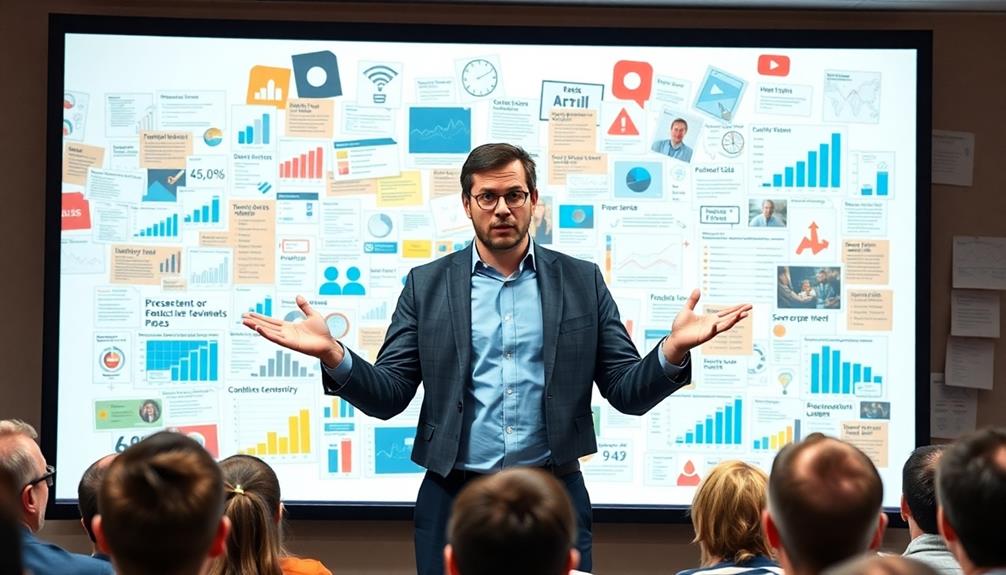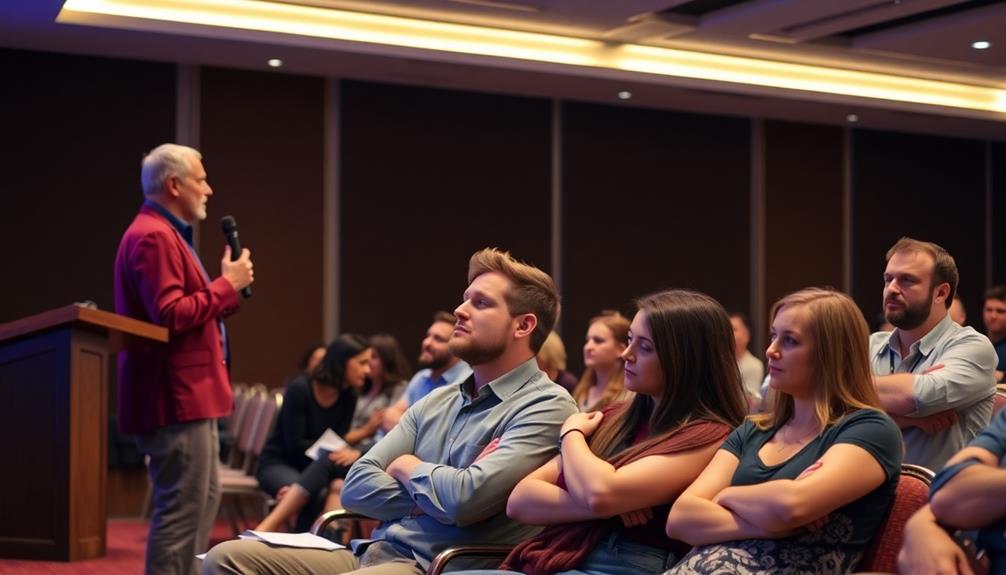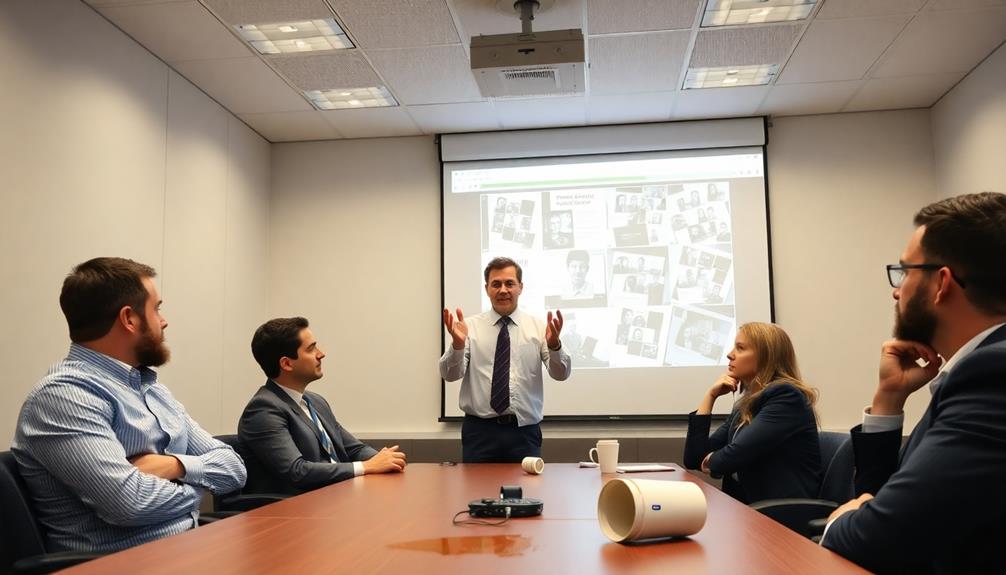Even experienced presenters can make critical speaking mistakes. First, they often fail to connect with the audience, which stifles engagement. Second, overloading slides with too much information can overwhelm listeners and reduce retention. Ignoring non-verbal cues is another pitfall, as body language can convey confidence and trust. Many mismanage time, rushing through points or cutting Q&A short, which can frustrate the audience. Ultimately, underestimating the importance of preparation can derail even the best talks. Get ready to sharpen your skills and avoid these common traps for more effective presentations ahead!
Key Takeaways
- Failing to engage the audience through eye contact and interaction can reduce interest and connection.
- Overloading slides with text distracts, making it difficult for the audience to retain key messages.
- Ignoring non-verbal cues like body language and gestures can undermine perceived confidence and engagement.
- Mismanaging time during presentations can signal poor preparation and disrespect for the audience's time.
- Underestimating the importance of preparation may lead to disorganized content and reduced audience engagement.
Lack of Audience Connection

Connection is essential for effective presentations. When you fail to engage your audience, you undermine your key messages. A lack of eye contact can create barriers, making it hard for listeners to connect with you. If you don't make eye contact, your audience can't feel that rapport, and they might tune out.
Instead, focus on your body language—show that you're present and invested in their experience. Additionally, leveraging techniques like NLP in customer experience can enhance your connection with the audience by tailoring your messaging to their needs.
Incorporating storytelling is a powerful way to engage your audience emotionally. Facts alone often fall flat without relatable anecdotes that resonate with listeners. By weaving stories into your presentation, you can capture attention and encourage participation.
Don't shy away from asking questions or using polls to invite interaction; this gives your audience a chance to share their thoughts, making them feel valued.
Overloading Slides With Information

Engaging your audience goes beyond just making eye contact; it also involves presenting information in a way that's easy to digest. Overloading slides with excessive text can overwhelm your audience, leading to decreased message retention and engagement.
Cognitive psychology tells us that individuals can only process a limited amount of information at once. To enhance clarity, focus on distilling your content into key points. For instance, consider the best beach towels of 2023 that emphasize absorbency and quick drying without excessive detailing, allowing users to easily choose what meets their needs.
Consider these guidelines for effective communication:
- Follow the 10/20/30 rule: Use no more than 10 slides, keep your presentation under 20 minutes, and use a 30-point font for readability.
- Create clear and concise slides: Use bullet points and relevant visuals to convey your message without clutter.
- Utilize visual aids: Guarantee they complement your spoken content rather than replace it, avoiding cluttered slides that distract from your main message.
Ignoring Non-Verbal Cues

Mastering the art of non-verbal communication is essential for every presenter. Ignoring non-verbal cues can lead to serious mistakes, impacting how your audience perceives your confidence and engagement. Body language, eye contact, and purposeful gestures play a significant role in building rapport.
| Non-Verbal Element | Impact on Presentation |
|---|---|
| Body Language | Conveys confidence and openness |
| Eye Contact | Fosters trust and connection |
| Gestures | Enhances clarity of your message |
| Facial Expressions | Reflects your engagement level |
| Posture | Indicates confidence and authority |
When you maintain eye contact, you engage your audience effectively, while avoiding it creates a sense of disconnection. Purposeful gestures can clarify your message, but excessive or distracting movements may divert attention away from your content. To improve your non-verbal communication, practice in front of a mirror or record your sessions. This way, you can identify habits that need adjustment to better connect with your audience. By being aware of these non-verbal elements, you can deliver a more impactful presentation and avoid common mistakes.
Mismanaging Time Effectively

Time management is essential for delivering an effective presentation. Mismanaging your time can lead to exceeding your allotted time, which not only shows poor preparation but also disrespects your audience.
To avoid common presentation mistakes, consider these public speaking tips to help you stay on track: To avoid common presentation mistakes, consider these public speaking tips to help you stay on track: Start by practicing thoroughly to ensure you’re confident with your material, as a lack of preparation is one of the most common mistakes in public speaking. Additionally, focus on maintaining eye contact and engaging with your audience to avoid appearing distracted or disconnected. Remember, preparation and connection are key to delivering a strong and effective presentation.
- Practice Your Timing: Rehearse your presentation multiple times to guarantee you cover all key points without rushing. This helps maintain audience attention.
- Use the 10/20/30 Rule: Limit your slides to no more than 10, keep your presentation to 20 minutes, and use a font size of at least 30 points. This promotes clarity and engagement.
- Allocate Time for Q&A: Plan for a Q&A session at the end of your presentation. This enhances audience interaction, but be strategic about when to include it to avoid diluting your main message.
Using a countdown clock can also help you manage your time effectively.
Underestimating Preparation Importance

Even with effective time management, the success of your presentation hinges on how well you prepare. Insufficient preparation can derail even the most experienced presenters, leading to poor performance.
When you invest time in rehearsal, you'll notice a boost in your confidence levels and improved audience engagement. To enhance your effectiveness, set clear goals and create structured outlines that keep your message coherent and impactful. Additionally, incorporating presentation training techniques can elevate your skills and guarantee you're well-prepared.
Don't underestimate the importance of audience research. Failing to tailor your messages can result in content misalignment, leaving your audience disengaged. Preparation isn't just about knowing your material; it's about understanding who you're speaking to.
Presentation training can sharpen your skills, but without thorough preparation, even the best training falls flat. Rehearsing helps you anticipate potential questions, making you better equipped to handle Q&A sessions.
When you take the time to prepare, you're setting yourself up for success. Remember, every moment spent preparing is an investment in your effectiveness as a speaker. Prioritize preparation, and you'll see the difference it makes in your presentations.
Frequently Asked Questions
What Is a Common Error That Presenters Make?
One common error you might make is relying too much on slides. This can disengage your audience, as they often prefer connecting with you instead of reading text on a screen during your presentation.
What Are the 10 Most Common Mistakes Done by People When They Make Presentations?
Did you know 40% of audiences lose interest within the first 10 minutes? Common mistakes include insufficient prep, overusing slides, ignoring audience needs, avoiding eye contact, and poor time management, all of which can disengage your listeners.
What Is the Number One Mistake Most Public Speakers Make?
The number one mistake you make as a public speaker is not preparing adequately for your audience. When you fail to understand their needs, your message loses relevance, leading to disengagement and ineffective communication.
What Is the Biggest Mistake Speakers Can Make in Ceremonial Speaking?
When you stand before an audience, the biggest mistake you can make is failing to connect emotionally. It's crucial to engage them; otherwise, your message risks fading into oblivion, leaving the ceremony hollow and forgettable.
Conclusion
To conclude, even seasoned speakers stumble into common traps. By building bonds with your audience, simplifying slides, sensing non-verbal signals, managing minutes wisely, and prioritizing preparation, you can present with poise and power. Don't let these pitfalls pull you down; instead, practice purposeful presentations that resonate. Remember, it's not just about speaking—it's about sparking connections and sharing stories. So, step up, shine bright, and let your voice be heard!










